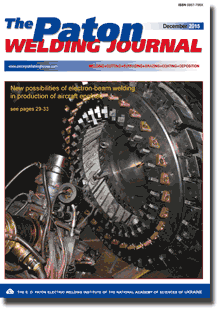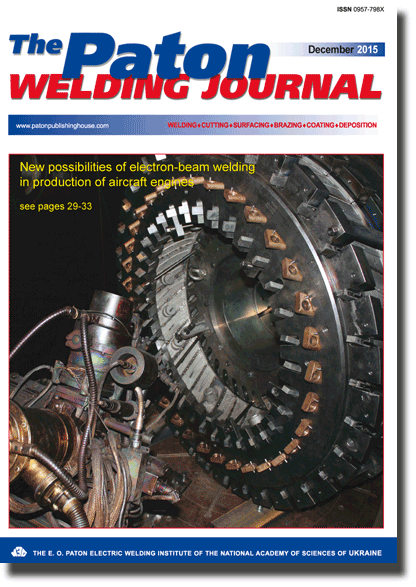| 2015 №12 (02) |
DOI of Article 10.15407/tpwj2015.12.03 |
2015 №12 (04) |

The Paton Welding Journal, 2015, #12, 14-18 pages
Improving the efficiency of hybrid welding of aluminum alloys
V.Yu. Khaskin2, V.N. Korzhik2, V.N. Sydorets2, A.I. Bushma2, Wu Boyi1 And Luo Ziyi1
1Chinese-Ukrainian E.O. Paton Welding Institute (Guangdong General Research Institute of Industrial Technology) (Guangzhou Research Institute of Non-Ferrous Metals). 363 Changxing Road, Tianhe, 510650, Guangzhou, China. E-mail: vnkorzhyk@gmail.com
2E.O. Paton Electric Welding Institute, NASU. 11 Bozhenko Str., 03680, Kiev, Ukraine. E-mail: office@paton.kiev.ua
Abstract
Development of new laser-arc heat sources is one of the urgent directions of modern science and engineering in the field of fusion welding of metals. Allowing for their physical features can promote increase of laser-arc welding productivity due to improvement of effective efficiency, i.e. increase of the ratio of power of the heat source applied to the metal in welding to the total power of the electric arc and laser radiation. One of the ways to improve the effective efficiency of welding is reduction of laser energy losses associated with radiation reflection from the surface being welded. The work is a study of the influence of concurrent heating, provided by the electric arc, on the change of the conditions of laser radiation absorption by aluminum alloys in their laser-arc welding. The problem of determination of temperature dependence of the coefficient of laser radiation absorption by aluminum was defined and solved within the model of almost free electrons on the base of studying vapour-gas channel behavior in hybrid welding. Comparison of obtained calculation dependencies of absorption capacity with the available experimental data showed satisfactory agreement. The respective heat conductivity equation was solved, in order to determine such parameters of laser-arc welding mode as arc component power and distance between the arc impact zone and laser beam axis. Experimental verification of the proposed approach to increase of effective efficiency of laser welding, performed on samples of aluminum alloy AMg6, confirmed the validity of the predicted results. 12 Ref., 7 Figures.
Keywords: laser-arc welding, aluminum alloys, CO2-laser radiation, absorption coefficient, welding current, welding speed
Received: 30.09.15
Published: 21.01.16
References Shelyagin, V.D., Khaskin, V.Yu. (2002) Tendencies in development of laser-arc welding (Review). The Paton Welding J., 6, 25-28. Grigoriants, A.G. (1988) Laser equipment and technology: Refer Book. Vol. 5: Laser welding of metals. Moscow: Vysshaya Shkola. Noskov, M.M. (1983) Optical and magneto-optical properties of metals. Sverdlovsk: UNTs AN SSSR. Kiselev, A.I., Akashev, L.A., Kononenko, V.I. (2004) Effective mass of electrons in the alloys of aluminum, cesium and binary system Al-3 at.% Ce. Zhurnal Tekhnich. Fiziki, 74(3), 20-23. Zinoviev, V.E. (1989) Thermal properties of metals at high temperatures: Refer. Book. Moscow: Metallurgiya. Ujihara, K. (1972) Reflectivity of metals at high temperatures. J. Appl. Physics, 43(5), 2376-2383. https://doi.org/10.1063/1.1661506 Ordal, M.A., Long, L.L., Bell, R.J. et al. (1983) Optical properties of the metals Al, Co, Cu, Au, Fe, Pb, Ni, Pd, Pt, Ag, Ti, and W in the infrared and far infrared. Appl. Optics, 22(7), 1099-1119. https://doi.org/10.1364/AO.22.001099 Miller, J.C. (1969) Optical properties of liquid metals at high temperatures. Phil. Magazine, Issue 168, 20(12), 1115-1132. https://doi.org/10.1080/14786436908228198 Comins, N.R. (1972) The optical properties of liquid metals. Ibid., Issue 4, 25, 817-831. https://doi.org/10.1080/14786437208229306 Peacemen, D.W., Rachford, H.H. (1955) The numerical solution of parabolic and elliptic differential equations. J. Soc. Ind. Appl. Math., 3, 28-41. https://doi.org/10.1137/0103003 Beletsky, V.M., Krivov, G.A. (2005) Aluminum alloys (composition, properties, technology, application): Refer. Book. Kiev: Komintekh. Garashchuk, V.P., Shelyagin, V.D., Nazarenko, O.K. et al. (1997) Technological CO2-laser LT104 of 10kW power. Avtomatich. Svarka, 1, 36-39.
Suggested Citation
V.Yu. Khaskin, V.N. Korzhik, V.N. Sydorets, A.I. Bushma, Wu Boyi And Luo Ziyi (2015) Improving the efficiency of hybrid welding of aluminum alloys. The Paton Welding J., 12, 14-18.The cost of subscription/purchase order journals or individual articles
| Journal/Currency | Annual Set | 1 issue printed |
1 issue |
one article |
| TPWJ/USD | 384 $ | 32 $ | 26 $ | 13 $ |
| TPWJ/EUR | 348 € | 29 € | 24 € | 12 € |
| TPWJ/UAH | 7200 UAH | 600 UAH | 600 UAH | 280 UAH |
| AS/UAH | 1800 UAH | 300 UAH | 300 UAH | 150 UAH |
| AS/USD | 192 $ | 32 $ | 26 $ | 13 $ |
| AS/EUR | 180 € | 30 € | 25 € | 12 € |
| SEM/UAH | 1200 UAH | 300 UAH | 300 UAH | 150 UAH |
| SEM/USD | 128 $ | 32 $ | 26 $ | 13 $ |
| SEM/EUR | 120 € | 30 € | 25 € | 12 € |
| TDNK/UAH | 1200 UAH | 300 UAH | 300 UAH | 150 UAH |
| TDNK/USD | 128 $ | 32 $ | 26 $ | 13 $ |
| TDNK/EUR | 120 € | 30 € | 25 € | 15 € |
AS = «Automatic Welding» - 6 issues per year;
TPWJ = «PATON WELDING JOURNAL» - 12 issues per year;
SEM = «Electrometallurgy Today» - 4 issues per year;
TDNK = «Technical Diagnostics and Non-Destructive Testing» - 4 issues per year.


